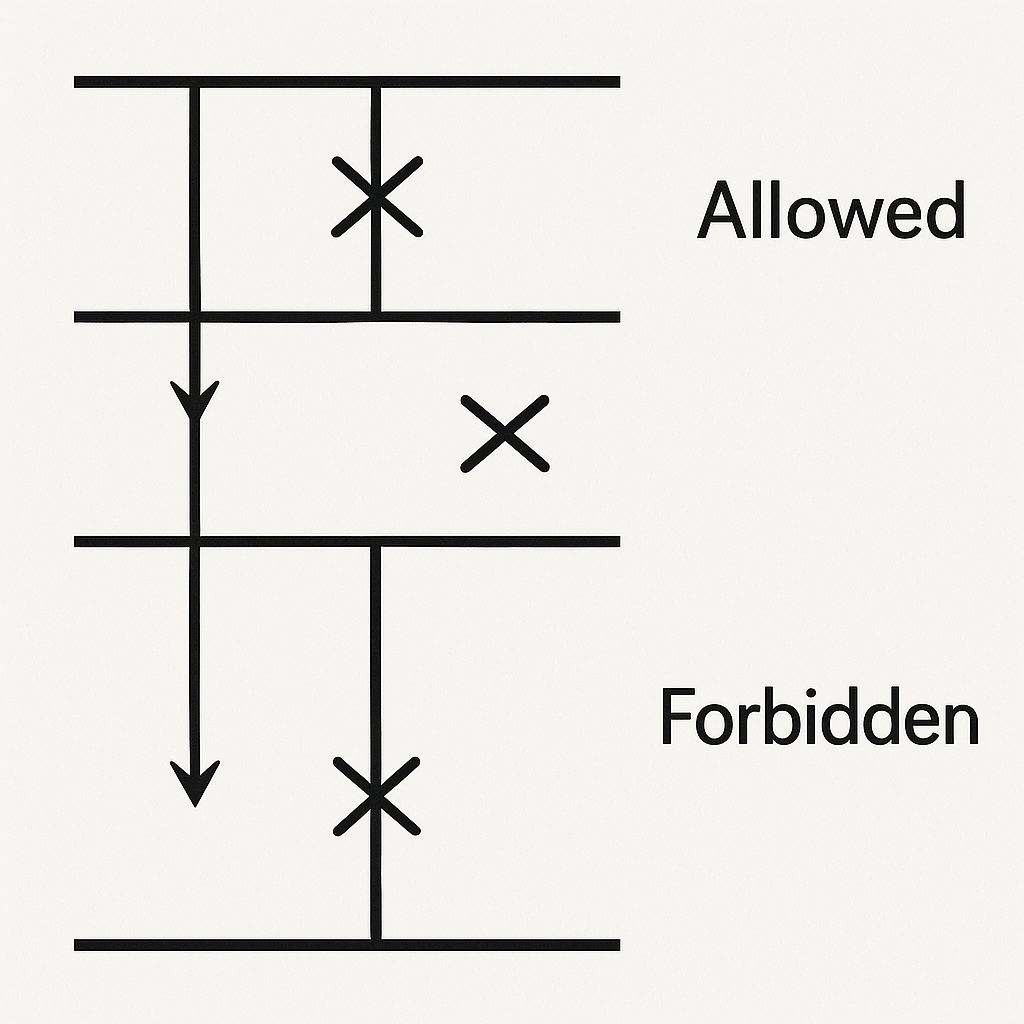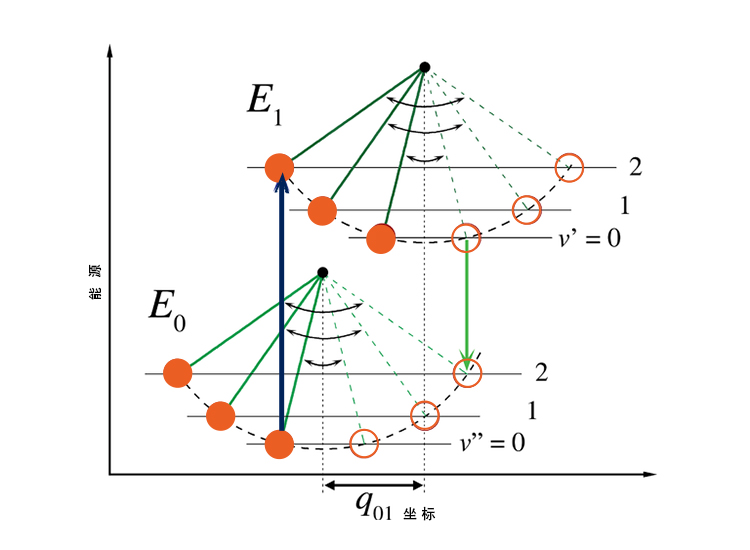Atomic physics holds an fascinating paradox: some key tech apps rely on transitions theoretically “forbidden”. These forbidden atomic transitions form backbone of precision timekeeping, high - energy laser systems, and quantum tech. They aren’t truly impossible. They show nature’s way to create long - lived excited states. Scientists have harnessed them for great apps.

Atoms and ions have distinct energy levels. Electrons occupy specific quantum states, set by fundamental selection rules. When atoms absorb or emit light, transitions must meet quantum mechanical requirements. This is about changes in angular momentum and parity.
The most common, strongest transitions are electric dipole transitions. They follow strict rules: orbital angular momentum quantum number (l) must change by ±1 exactly. Transitions between states of same parity aren’t allowed.
Yet nature offers alternative paths for transitions that break these main rules. These “forbidden” transitions happen via complex mechanisms—like electric quadrupole interactions or magnetic dipole processes. But they go much slower than allowed transitions. Quantum mechanical matrix elements for these processes are usually 4 - 6 orders smaller than electric dipole ones. So upper - state lifetimes get much longer.
Classification of forbidden transitions depends on specific mechanism and broken rules. Electric quadrupole transitions break standard dipole rules but allow Δl = 0, ±2. They’re the most common weakly forbidden type used in apps.
These transitions usually have upper - state lifetimes from microseconds to milliseconds. Allowed transitions have nanoseconds.
Magnetic dipole transitions are another category. They matter much for atomic clocks. Their extremely long lifetimes can stretch from milliseconds to years.
The link between lifetime and spectral linewidth follows Heisenberg uncertainty principle (ΔE·Δt ≥ ℏ/2). Longer - lived states make narrower spectral lines. This inverse link makes forbidden transitions priceless for apps needing precise frequency standards.

Most solid - state laser systems rely on weakly allowed transitions. These are forbidden transitions made partly possible by crystal environment.
When laser - active ions sit on crystal lattices or glasses, internal electric and magnetic fields break symmetries. These symmetries would normally block these transitions fully. This symmetry breaking lets what’s strictly forbidden in isolated atoms become weakly allowed. But their oscillator strengths are still way smaller than fully allowed ones.
Longer upper - state lifetimes of these weakly allowed transitions give crucial perks for laser operation. Extended storage time lets energy build up in upper laser level before stimulated emission. This enables high - energy laser pulses via Q - switching. Common solid - state laser materials—Nd:YAG, Er:glass, Yb - doped crystals—all use these forbidden transition mechanisms.
Combination of long upper - state lifetimes and low transition cross - sections in solid - state lasers also causes relaxation oscillations and spiking. When pump power jumps, these lasers show damped oscillations as population dynamics adjust to new balance. This comes straight from the weakly forbidden nature of laser transitions.
Forbidden transitions find their most precise use in optical atomic clocks. Extremely narrow linewidths from long - lived transitions let frequency stability hit new highs.
Clock transitions often use magnetic dipole or highly forbidden electric transitions in isolated atoms or ions. Upper - state lifetimes can reach years. Cesium atomic clock, for example, relies on a hyperfine transition with effective lifetime way longer than typical electronic transitions.
Challenge in optical clock apps is the very trait that makes these transitions valuable: low transition rates make them hard to observe and check. Ultra - low densities and super long interaction times are needed to get enough signal. This needs fancy laser cooling and trapping techniques. But the resulting frequency precision—linewidths maybe narrower than 1 Hz at optical frequencies—lets timing accuracy beat all other known standards.
Apps of forbidden transitions go far beyond lasers and clocks, into many tech areas. On astrophysics, forbidden transitions on low - density interstellar spots make many spectral lines seen in nebulae and aurora. Collision rates there are too low to quench metastable states.
These long - lived states work on quantum computing too. Extended coherence times are key for quantum info processing.
Medical and industrial laser systems mostly depend on energy storage from forbidden transitions. The ability to store energy in metastable states and release fast enables apps from precision surgery to heavy industrial cutting and welding. Pulse energies from Q - switching solid - state lasers can hit millijoule to joule range. Peak powers are orders higher than continuous - wave operation.
A counterintuitive part of forbidden transitions is the link between transition strength and laser gain. Forbidden transitions have smaller emission cross - sections (σ) than allowed ones. But their longer upper - state lifetimes (τ) can make σ·τ bigger. This product decides achievable laser gain. So forbidden transitions can give higher gain than allowed ones under right conditions. That explains why they rule in high - performance laser systems.
Spontaneous emission from forbidden transitions is also weak. This cuts competition for stored energy and lets more efficient extraction during stimulated emission. This trait boosts high efficiency and energy storage, making solid - state lasers work for high - power apps.
Forbidden atomic transitions show how apparent limits in physical systems turn into tech advantages via science and engineering. What quantum mechanics blocks with selection rules, smart apps have made into foundation of precision measurement, high - energy lasers, and advanced quantum tech. The long lifetimes that make these transitions “forbidden” become the very thing that enables energy storage, ultra - narrow linewidths, and extended coherence times.
As tech advances toward higher precision and tougher apps, forbidden transitions will likely play bigger role. From next - gen optical atomic clocks to advanced quantum computers and more powerful lasers, physics of forbidden transitions offers rich ground for new ideas. The lesson is clear: on quantum world, what’s forbidden often becomes essential. Understanding these subtle effects opens doors to tech that’d otherwise be impossible.
Contact: Jason
Phone: +8613337332946
E-mail: [email protected]
Add: Hangzhou City, Zhejiang Province, China